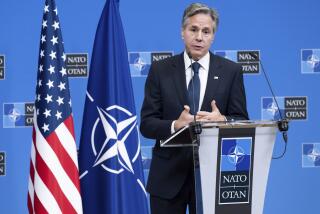Market Newsletter : ‘Fortress Europe’: The Fear Fades : Looking ahead to 1992, Europeans have spun out reams of rules to define the unified market. And despite some nagging concerns, the U.S. is less nervous about access and protectionism.
- Share via
WASHINGTON — Visions of a Fortress Europe--the fear that the European drive to create an integrated market by 1992 would lead to increased protectionism--have abated, but some nagging problems remain.
Despite a few skirmishes at the start, U.S. policy-makers and businessmen agree that the Europeans by and large have kept their promises to make the new “single market” open to Europeans and foreigners alike.
While there are “some serious concerns and problems with specific EC (European Community) policies, . . . they are overshadowed by the growth opportunities presented by the EC market,” a new report issued by the National Assn. of Manufacturers concludes.
Michael Calingaert, a Brussels-based EC-watcher for the Pharmaceutical Manufacturers Assn., said: “I always thought that ‘Fortress Europe’ was a rather silly dialogue on both sides. I think the whole discourse has moved into the background.”
That buoyant assessment has been borne out in practice by the burst of directives and regulations that the EC has issued to lay the groundwork for 1992. About 145 of them have been formally adopted so far--out of 282 originally expected--and more are coming each day. Stanley Crossick, a partner in Belmont, a Brussels-based consulting firm that keeps tabs on the 1992 effort for U.S. corporations, says the consensus is that both on these and on larger issues, the EC “has been sensitive” to U.S. concerns.
A banking directive was drastically overhauled after Washington complained it might discriminate against U.S. financial institutions. And Eurocrats are giving U.S. firms an early look at new regulations so that they can voice any complaints before the rules are adopted.
Meanwhile, American firms are riding a wave of trade with Europe.
The $22.6-billion trade deficit the United States ran with EC countries in 1986 has turned into a $1.5-billion surplus. “The growth in EC demand for U.S. exports should continue,” the NAM report says.
American investment in Europe is also accelerating.
To be sure, even the most optimistic Eurowatchers concede that the road to 1992 will not be entirely bump-free. The Europeans are playing much tougher with Japan, forcing Tokyo to set stiff export limits on cars and insisting that Japan buy parts and labor in the 12 EC nations.
And U.S. officials point out that while the policy-making European Commission may seem open-minded in setting broad policies on 1992, there still is a danger that it will succumb to demands for protection from individual industries before a new, integrated market is in place. “What we’re concerned about is not Fortress Europe,” an American-based EC-watcher for a major U.S. corporation declared. “What we’re concerned about is the (European) Commission giving relief to specific industries.”
U.S. firms are also nervously eyeing a spate of second-level issues, from buy-European provisions in government procurement guidelines to regulations governing local content and place of origin.
“The concern of people now is to see how the nitty-gritty things work out,” said Eamonn J. Bates, a partner in Bernard Krief Europe, another Brussels-based EC-watching firm that represents American corporations and other foreign-based companies.
Among the items on current U.S. watch lists:
Standards, testing and certification. The Europeans, by promising to show Americans proposed new standards earlier and permitting U.S. testing labs to act as surrogates in certifying products, have gone a long way toward meeting earlier U.S. fears that the certification process would act to bar U.S. products.
But the issue remains far from fully resolved. While Europe has consolidated its testing into two or three laboratories that serve the entire continent, the U.S. system involves separate, industry-run labs for each sector. American industry is divided over whether the United States should make its system more compatible with Europe’s.
Rules of origin, local content and sectoral issues. Although the EC has no broad-scale policies mandating that goods be produced either partly or largely in Europe, it has moved toward minimum requirements for TV program production, electronics and autos.
U.S. strategists fret that the number could grow before the 1992 process is fully in effect. The European Commission ruled last February that microchip makers will have to fabricate their wafers in Europe to qualify for new EC trade preferences.
Subsidies. Despite all the rhetoric, the commission appears still wedded to continuing the widespread subsidies that European governments traditionally have provided to businesses on the Continent for research and development, investment and exports.
To U.S. business, these grants and aid--much more than the United States provides for its businesses here--are unfair. Washington is trying to persuade Europe to reduce them as part of the current round of global trade-liberalization talks, but success seems unlikely.
Trading Across the Atlantic
Leading U.S. Exports to the EEC
In U.S. dollars (1989) Aircraft and related equipment: 9,213,476,407 Automatic data processing equipment: 5,542,476,605 Parts of office machines: 4,473,826,260 Engines and motors for gas turbines, etc.: 3,720,353,656 Technical measuring equipment: 2,691,946,750
Leading U.S. Imports to the EEC
In U.S. dollars (1989) Petroleum products, refined: 2,376,265,592 Alcoholic beverages: 2,386,322,600 Military and other special transactions: 2,742,625,327 Aircraft and related equipment: 3,396,178,846 Passenger vehicles: 7,036,661,434
SOURCE: Data Resources Inc./McGraw Hill
More to Read
Inside the business of entertainment
The Wide Shot brings you news, analysis and insights on everything from streaming wars to production — and what it all means for the future.
You may occasionally receive promotional content from the Los Angeles Times.










